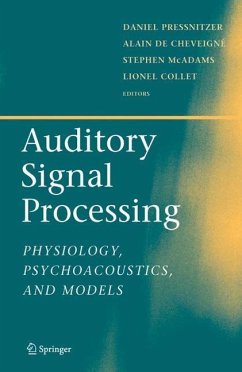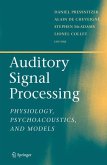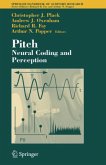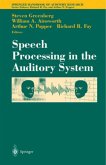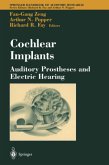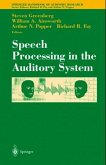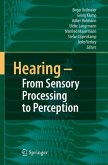The result of extensive collaboration among leaders of the worldwide auditory research community, Auditory Signal Processing: Physiology, Psychoacoustics, and Models is a record of the papers presented at the XIIIth International Symposium on Hearing (ISH) Dourdan, France, August 24-29, 2003. The volume includes a total of 62 invited papers, organized into 12 broad thematic areas: cochlear signal processing; brainstem signal processing; pitch; frequency modulation; streaming; amplitude modulation; responses to complex sounds; speech; comodulation masking release; binaural hearing; temporal coding; and plasticity.
This book contains the papers that were presented at the XIIIth International Symposium on Hearing (ISH), which was held in Dourdan, France, between August 24 and 29, 2003. From its first edition in 1969, the Symposium has had a distinguished tradition of bringing together auditory psychologists and physiologists. Hearing science now also includes computational modeling and brain imaging, and this is reflected in the papers collected. The rich interactions between participants during the meeting were yet another indication of the appositeness of the original idea to confront approaches around shared scientific issues. A total of 62 solicited papers are included, organized into 12 broad thematic areas ranging from cochlear signal processing to plasticity and perceptual learning. The themes follow the sessions and the chronological order of the paper presentations during the symposium. A notable feature of the ISH books is the transcription of the discussions between participants. A draft version of the book is circulated before the meeting, and all participants are invited to make written comments, before or during the presentations. This particularity is perhaps what makes the ISH book series so valuable as a truthful picture of the evolution of issues in hearing science. We tried to uphold this tradition, which was all the easier because of the excellent scientific content of the discussions.
This book contains the papers that were presented at the XIIIth International Symposium on Hearing (ISH), which was held in Dourdan, France, between August 24 and 29, 2003. From its first edition in 1969, the Symposium has had a distinguished tradition of bringing together auditory psychologists and physiologists. Hearing science now also includes computational modeling and brain imaging, and this is reflected in the papers collected. The rich interactions between participants during the meeting were yet another indication of the appositeness of the original idea to confront approaches around shared scientific issues. A total of 62 solicited papers are included, organized into 12 broad thematic areas ranging from cochlear signal processing to plasticity and perceptual learning. The themes follow the sessions and the chronological order of the paper presentations during the symposium. A notable feature of the ISH books is the transcription of the discussions between participants. A draft version of the book is circulated before the meeting, and all participants are invited to make written comments, before or during the presentations. This particularity is perhaps what makes the ISH book series so valuable as a truthful picture of the evolution of issues in hearing science. We tried to uphold this tradition, which was all the easier because of the excellent scientific content of the discussions.

